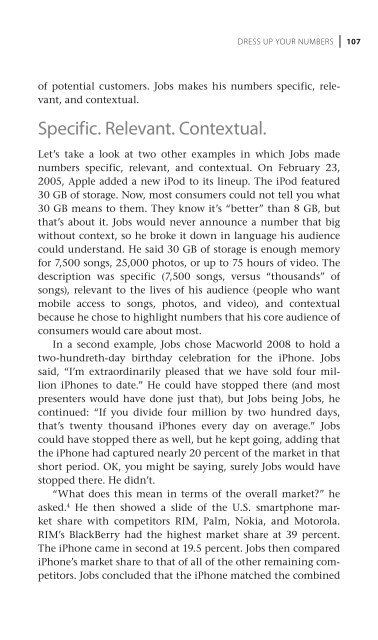Presentation-Secrets-Of-Steve-Jobs
Create successful ePaper yourself
Turn your PDF publications into a flip-book with our unique Google optimized e-Paper software.
DRESS UP YOUR NUMBERS 107<br />
of potential customers. <strong>Jobs</strong> makes his numbers specific, relevant,<br />
and contextual.<br />
Specific. Relevant. Contextual.<br />
Let’s take a look at two other examples in which <strong>Jobs</strong> made<br />
numbers specific, relevant, and contextual. On February 23,<br />
2005, Apple added a new iPod to its lineup. The iPod featured<br />
30 GB of storage. Now, most consumers could not tell you what<br />
30 GB means to them. They know it’s “better” than 8 GB, but<br />
that’s about it. <strong>Jobs</strong> would never announce a number that big<br />
without context, so he broke it down in language his audience<br />
could understand. He said 30 GB of storage is enough memory<br />
for 7,500 songs, 25,000 photos, or up to 75 hours of video. The<br />
description was specific (7,500 songs, versus “thousands” of<br />
songs), relevant to the lives of his audience (people who want<br />
mobile access to songs, photos, and video), and contextual<br />
because he chose to highlight numbers that his core audience of<br />
consumers would care about most.<br />
In a second example, <strong>Jobs</strong> chose Macworld 2008 to hold a<br />
two-hundreth-day birthday celebration for the iPhone. <strong>Jobs</strong><br />
said, “I’m extraordinarily pleased that we have sold four million<br />
iPhones to date.” He could have stopped there (and most<br />
presenters would have done just that), but <strong>Jobs</strong> being <strong>Jobs</strong>, he<br />
continued: “If you divide four million by two hundred days,<br />
that’s twenty thousand iPhones every day on average.” <strong>Jobs</strong><br />
could have stopped there as well, but he kept going, adding that<br />
the iPhone had captured nearly 20 percent of the market in that<br />
short period. OK, you might be saying, surely <strong>Jobs</strong> would have<br />
stopped there. He didn’t.<br />
“What does this mean in terms of the overall market?” he<br />
asked. 4 He then showed a slide of the U.S. smartphone market<br />
share with competitors RIM, Palm, Nokia, and Motorola.<br />
RIM’s BlackBerry had the highest market share at 39 percent.<br />
The iPhone came in second at 19.5 percent. <strong>Jobs</strong> then compared<br />
iPhone’s market share to that of all of the other remaining competitors.<br />
<strong>Jobs</strong> concluded that the iPhone matched the combined














![[Lonely Planet] Sri Lanka](https://img.yumpu.com/59845622/1/169x260/lonely-planet-sri-lanka.jpg?quality=85)


